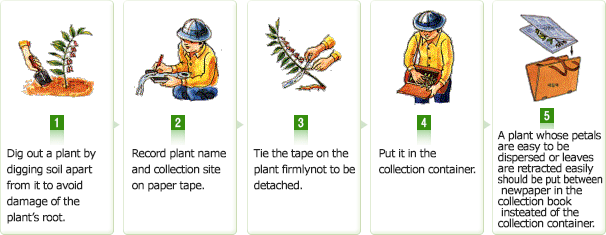- 글로벌메뉴
- KOREAN

 Korea Biodiversity Information System > Plant Resource > Plant class > Collection and Specimens
Korea Biodiversity Information System > Plant Resource > Plant class > Collection and Specimens
Because plant collection may damage the ecosystem, several precautions should be taken.
One matter to consider prior to collection is that all collected plants should be made into specimens and stored permanently.
In addition, prepared specimens should be provided to researchers for their use.
Because of this, plant and insect collection, which in the past was summer vacation homework, has disappeared.
There are also some places where plant collection is prohibited, including national, provincial, and county parks under the control of
the Ministry of Environment or local governments, nature preservation areas designated by the ministry, and natural monument areas designated
by the Ministry of Culture and Tourism. In addition, the collecting or breeding without permission of 126 plant species, such as Cymbidium goeringii Reichb,
Hanabusaya asiatica, and Epimedium koreanum NAKAI, which are designated as specific wild plants by the Ministry of Environment, is illegal.
Although it is possible to collect plants even in prohibited areas after obtaining permission from the relevant authorities, permission is usually not provided,
except for scientists or academic groups.
In conclusion, indiscriminate plant collection injures nature, which is an inheritance for the next generation, and is a prohibited act.
A long-sleeved shirt made of comfortable material should be worn for this activity, regardless of season.
Hiking boots are required, and when buying new ones, a reasonable-priced pair is recommended.
Female students should abstain from the use of cosmetic products, which may attract bees.
The tools required for plant collection are a shovel for roots, pruning scissors, and a collection bag.
Because proper collection cannot be accomplished by digging or breaking plants apart with your hands, these tools are essential.
While a shovel is usually used for digging up roots, a narrow trowel can also be used.
It is recommended that the shovel is made from a thick pipe 30 ㎝ in length (including 12 ㎝ for a handle) and about 3.5 ㎝ in diameter.
Collection bags should be made of transparent plastic 30 ㎝ wide and 60 ㎝ deep.
